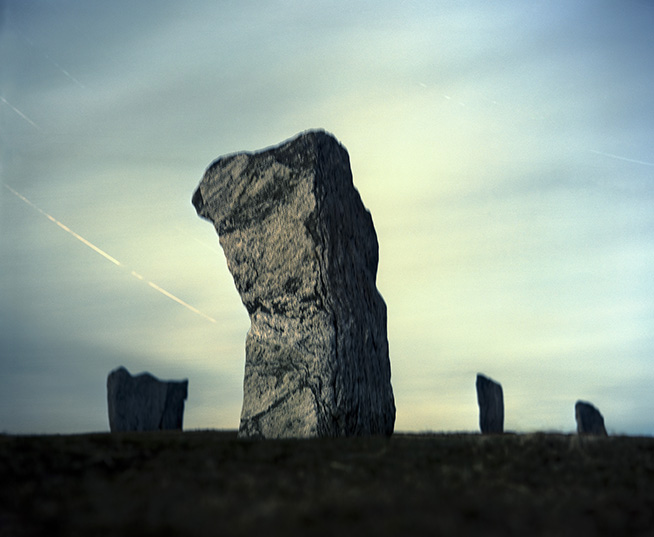
Callanish
I
Isle of Lewis, Scotland
Moonlight exposure of several hours
24x30 inch plexi-mounted metallic C-print
2010
Though an epochal snowstorm tried to keep us away from the Western Isles,
we eventually got through to our goal—the Standing Stones of Callanish.
Dated variously from 2900 to 2600 BCE, they predate the central stone
ring of Stonehenge by several hundred years and were likely the stones
referenced by the Greek explorer Pytheas in his 4th century BCE account
of his visit to the present-day British Isles.
In contrast to these stones, Nancy and I had encountered sinister stones
in our past. We'd traveled through a remote desert region of Portugal
years before and come upon three monumental boulders leaning against each
other to form a claustrophobic crevice. Nearby was a suspiciously human-sized
horizontal stone. It was difficult not to let our minds wander to the
thought of ugly sacrifices. Since these sorts of ruins pre-date any historical
record, it's especially tempting to assess a site based on how it "feels."
And this spot in Portugal "felt" bad. We left quickly.
The Standing Stones of Callanish, on the other hand, felt very happy to us. While they are, in fact, in an orderly pattern when viewed from the air, on the ground they feel friendly and informal. This perception stems partly from the fact that the individual stones are very different from each other in size and shape, and also from the fact that on the perimeter especially, they seem quite random in their placement. This all results in a peaceful feeling of co-existence between the stones themselves and between them and you as their guest. It doesn't mean that what they're doing there isn't serious, but they welcome you. In fact, as I was stumbling around the site with my gear in the near-pitch darkness before the moon had risen, I bumped into one of the stones. I uttered the first words that came to me. "Oh, excuse me," I said.
©MJ
Sharp / www.mjsharp.com